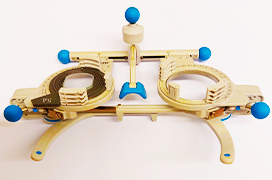Aims: To demonstrate changes in distance and near fusional vergence measured with prism bars, while compensating for present heterophoria using current ametropia correction. In addition, to determine the differences in values of the AC/A ratio determined by the heterophoric (calculation) and gradient methods.
Material and methods: The basic sample includes 19 subjects with a mean age of 21.5 ±3.0 years (min. 18, max. 27). We used the Von Graefe technique for examination of distance and near phoria, and prism bars for examination of fusion vergences measured in prism diopters. We divided the basic cohort into six research sets according to the size of distance and near heterophoria. This was a cohort of patients with distance (D OR) and near orthophoria (N OR), a cohort of patients with distance (D EX) and near exophoria (N EX) and a set of patients with distance (D ES) and near esophoria (N ES).
Results: In the case of both groups with exophoria (distance, near) we found a statistically significant result only for negative fusion vergence (NFV). There was a statistically significant increase in NFV in the sample with distance and near exophoria (D EX, p = 0.01 and B EX, p = 0.02, respectively). In our study, we also demonstrated a statistically significant difference (p < 0.001) in the values of the AC/A ratio measured by the gradient and heterophoric methods. The values determined by the gradient method are lower (3.0 ±1.1 pD/D versus 5.8 ±0.9 pD/D) than by the heterophoric method.
Conclusion: By comparing fusion vergence values in patients with exophoria and orthophoria, we demonstrated that in the presence of distance or near exophoria there is an increase in ipsilateral fusion vergence. In the case of an increase in ipsilateral fusion vergence, the finding was statistically significant both distance and near (p = 0.01 and p = 0.02, respectively). By contrast, we were unable to prove this fact in the group of patients with esophoria. In our study, we also demonstrated a statistically significant difference (p < 0.001) in the values of the AC/A ratio measured by the gradient and heterophoric methods. The values determined by the gradient method are lower (3.0 ±1.1 pD/D versus 5.8 ±0.9 pD/D) than by the heterophoric method.

